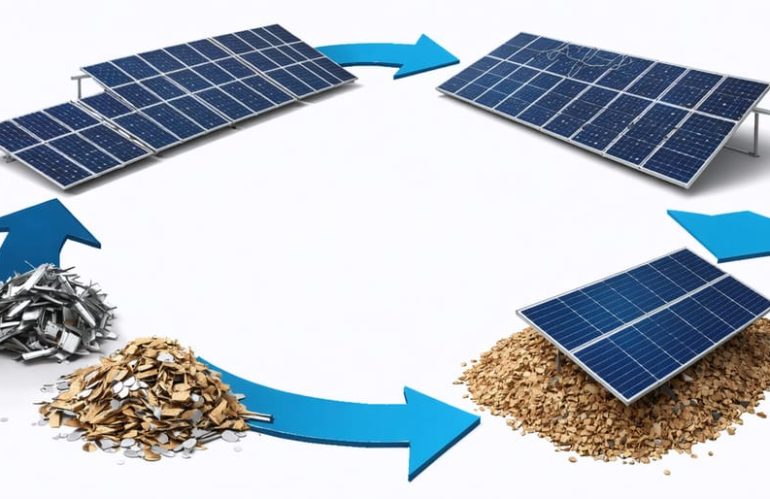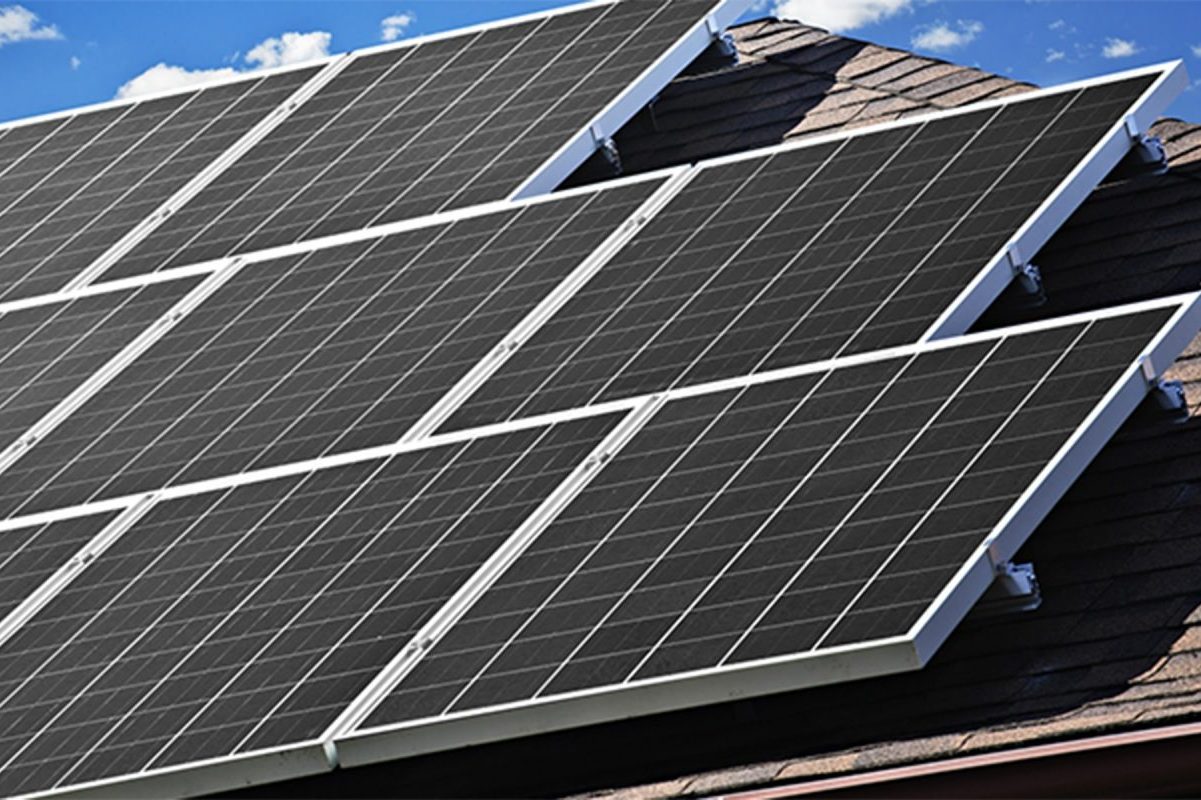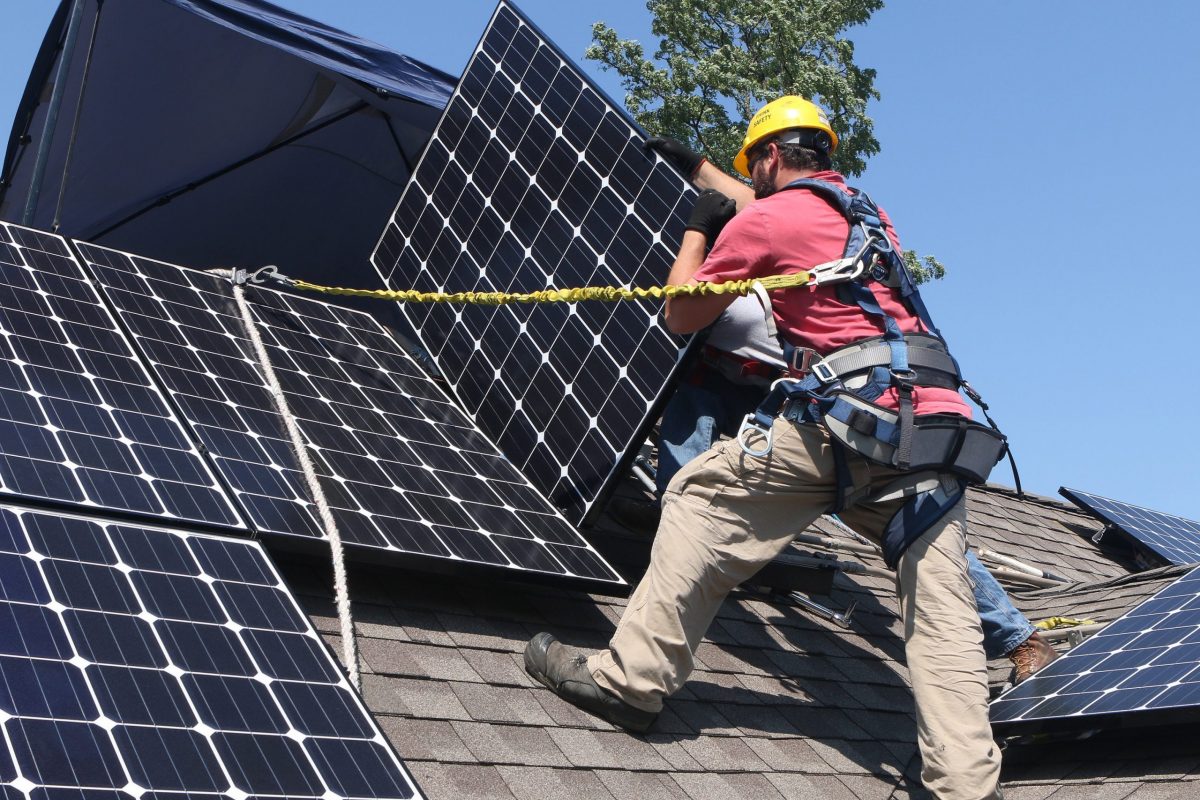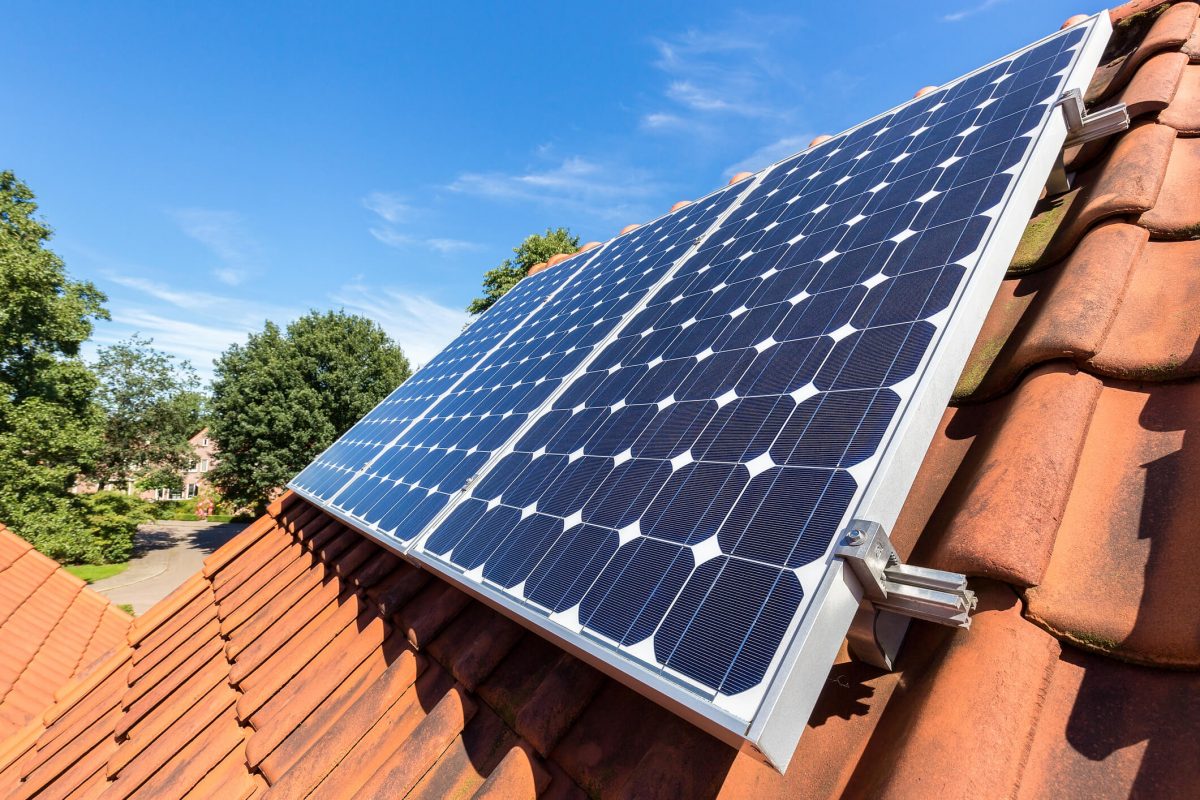Solar panel recycling has emerged as a crucial component of sustainable energy practices, addressing the growing need to manage end-of-life photovoltaic panels responsibly. As millions of solar installations approach their 25-30 year lifespan, the industry has developed sophisticated recycling processes that recover up to 95% of valuable materials, including silver, silicon, and aluminum. These recovered materials not only reduce landfill waste but also provide raw materials for new panel production, creating a circular economy in the solar industry. Understanding the recycling process is essential for homeowners and industry professionals alike, as proper disposal ensures environmental protection while complying with increasingly stringent regulations. This guide explores the step-by-step process of solar panel recycling, from collection to material recovery, helping you make informed decisions about panel disposal while contributing to a more sustainable future.
Why Solar Panel Recycling Matters
Valuable Materials in Solar Panels
Solar panels contain several valuable materials that can be recovered and reused through proper recycling. The most abundant component is glass, which makes up about 70% of each panel and can be easily recycled into new glass products. Silicon cells, the heart of solar panels, are highly valuable and can be extracted to create new solar cells or used in other electronics.
The aluminum frame surrounding each panel is also completely recyclable and in high demand across various industries. Precious metals like silver, copper, and lead are present in smaller quantities but are particularly valuable in the recycling market. These metals are found in the panel’s wiring and conducting strips.
Other recoverable materials include the plastic components, typically EVA (ethylene vinyl acetate), and the junction box. When properly separated, these materials can find new life in various manufacturing processes, reducing waste and supporting a circular economy. By recycling these components, we not only prevent valuable resources from ending up in landfills but also reduce the environmental impact of producing new materials.
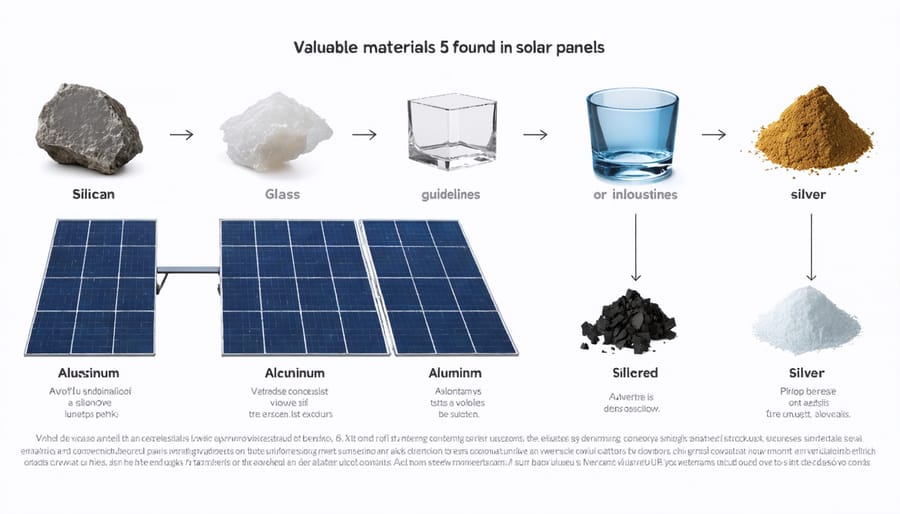
Environmental Benefits
Solar panel recycling plays a crucial role in reducing environmental waste and preserving valuable resources. When panels are properly recycled, up to 95% of their materials can be recovered and reused, significantly decreasing the demand for raw materials like silicon, glass, and precious metals. This conservation of resources helps reduce mining activities and their associated environmental impacts.
The recycling process prevents potentially harmful materials from entering landfills while minimizing the carbon footprint of solar energy production. Each recycled panel saves approximately 1.5 tons of CO2 emissions throughout its lifecycle. Additionally, recovering and reusing materials like silver and silicon requires less energy than extracting new resources, further reducing environmental impact.
By supporting the circular economy, solar panel recycling helps ensure that renewable energy remains truly sustainable. As the industry grows, efficient recycling processes become increasingly important in maintaining solar energy’s positive environmental impact and reducing electronic waste.
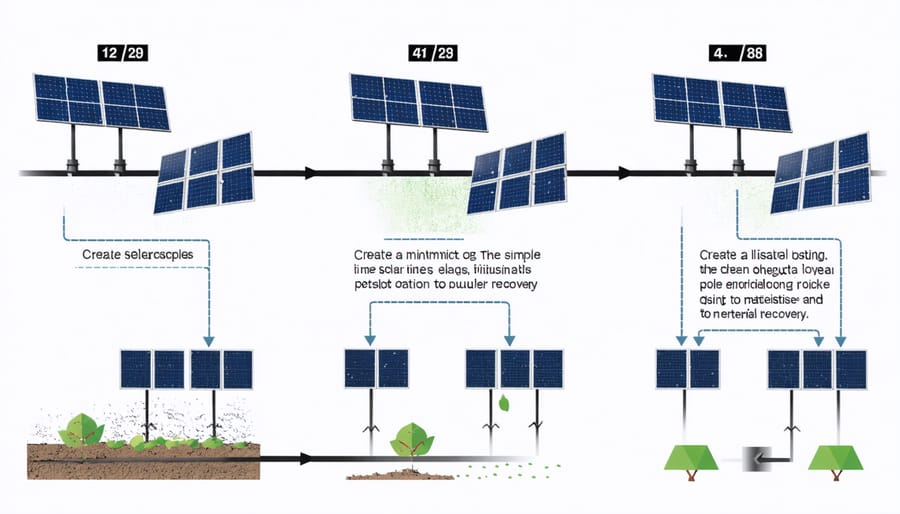
The Solar Panel Recycling Process Explained
Collection and Transportation
The journey of recycling solar panels begins with proper collection from homes, businesses, and solar farms. When panels reach the end of their 25-30 year lifespan or become damaged, certified waste management companies collect them using specialized equipment to prevent further damage. These companies carefully remove the panels from their mounting systems and package them securely for transport.
Transportation to recycling facilities requires careful handling to maintain the panels’ integrity. Trucks equipped with proper securing mechanisms and protective padding ensure safe delivery. Many recycling companies offer pickup services, making it convenient for homeowners and businesses to responsibly dispose of their old panels. Some manufacturers and installers also participate in take-back programs, coordinating the collection and transportation process as part of their service.
To ensure proper handling, panels are typically palletized and shrink-wrapped, protecting them from breakage during transit. This careful approach helps maximize the recovery of valuable materials during the recycling process.
Dismantling and Separation
The first step in recycling solar panels involves carefully dismantling them into their core components. Trained technicians begin by removing the aluminum frame, which is easily recyclable and can be processed separately. The glass surface, which makes up about 75% of the panel, is then carefully separated from the underlying materials.
Next, the panels go through a mechanical separation process where specialized equipment breaks down the remaining materials. The backing sheet is removed, and the silicon cells are separated from their embedding materials. This process typically involves using thermal and chemical treatments to dissolve the laminate holding everything together.
Advanced recycling facilities use automated systems to sort different materials. Metal components like copper wiring and silver contacts are extracted using electromagnetic separation techniques. The silicon cells, which are valuable for making new panels, undergo additional processing to remove any impurities.
The entire dismantling process ensures that maximum material recovery is achieved while maintaining the quality of recovered components. This systematic approach helps recover up to 95% of the materials from old solar panels, making them truly sustainable energy solutions.

Material Recovery
Once solar panels are dismantled, their valuable materials are carefully processed for reuse. The glass, which makes up about 75% of each panel, is separated and crushed into cullet for manufacturing new glass products. Aluminum frames are melted down and repurposed for various industrial applications. The silicon cells, containing precious metals like silver and copper, undergo specialized chemical treatment to extract these valuable materials.
The recovered silicon can be refined and used to produce new solar cells or electronics. Plastic components are processed into pellets for manufacturing new products, while copper wiring is stripped and prepared for reuse in electrical applications. This systematic recovery process ensures that up to 95% of a solar panel’s materials can be reclaimed and repurposed, significantly reducing waste while conserving natural resources.
Through these efficient recovery methods, recycled materials maintain their quality and can often be used to manufacture new solar panels, creating a sustainable cycle of renewable energy production.
Current Regulations and Requirements
Federal Guidelines
Currently, the United States doesn’t have comprehensive federal regulations specifically for solar panel recycling. However, solar panels are generally classified under the Resource Conservation and Recovery Act (RCRA) guidelines, which govern the disposal of electronic waste and potentially hazardous materials.
The Environmental Protection Agency (EPA) encourages voluntary recycling programs and provides guidance for proper disposal methods. Some states have taken the initiative to implement their own regulations, filling the gap in federal oversight. While not mandatory nationwide, the EPA recommends that solar panel owners work with certified recycling facilities to ensure proper handling of materials.
The federal government is actively developing more specific guidelines for solar panel recycling as the industry grows. These upcoming regulations are expected to address the increasing volume of panels reaching the end of their lifecycle. In the meantime, homeowners are encouraged to follow state-specific guidelines and work with manufacturers who offer take-back programs.
For now, the best practice is to consult with local waste management authorities or solar installation companies about proper disposal methods in your area.
State-Level Programs
Several states have implemented their own solar panel recycling programs and requirements, complementing federal guidelines. California leads the way with its comprehensive Solar Panel Collection and Recycling Program, requiring manufacturers to provide free recycling services to consumers. Washington state has established similar mandates, classifying solar panels as “covered electronic products” that must be properly recycled through authorized facilities.
Other states like New York and Massachusetts offer state-specific solar incentives that include recycling provisions. These programs often combine disposal requirements with financial benefits, making it easier and more affordable for homeowners to responsibly recycle their old panels.
Many states are currently developing their own recycling frameworks, with some offering tax incentives or partnering with local recycling facilities to create convenient drop-off locations. Before disposing of solar panels, homeowners should check their state’s environmental protection agency website or contact local solar installers to learn about available recycling programs and requirements in their area.
Financial Incentives for Recycling
Tax Benefits
Proper solar panel recycling not only benefits the environment but can also provide significant financial advantages through various tax incentives. Many states offer tax credits or deductions for environmentally responsible disposal of solar equipment. When combined with federal tax incentives, homeowners can recover a portion of their recycling costs. Some jurisdictions provide additional rebates for working with certified recycling facilities, which can offset up to 30% of the disposal expenses. Local utilities may also offer incentive programs that reward responsible disposal practices. To maximize these benefits, keep detailed records of your recycling transactions and consult with a tax professional who can help identify all available deductions. Remember that these incentives may vary by location and can change annually, so it’s worth checking current offerings in your area before proceeding with panel disposal.
Recycling Programs
Several recycling programs are now available to help homeowners responsibly dispose of their solar panels. Leading manufacturers like First Solar and SunPower offer take-back programs, allowing customers to return old panels directly to them for recycling. Many local waste management facilities have also established specialized solar panel collection points, making recycling more accessible to homeowners.
Organizations like PV Cycle in Europe and the Solar Energy Industries Association (SEIA) in the US operate collection networks that connect consumers with certified recyclers. These programs not only ensure proper disposal but often provide documentation for tax incentives or environmental compliance.
The benefits of these programs extend beyond environmental responsibility. Many offer cost savings through bulk collection services, while some even provide partial refunds for recyclable materials. Additionally, participating in authorized recycling programs helps homeowners comply with local disposal regulations and contributes to the circular economy of solar materials.
As we’ve explored, solar panel recycling is not just an environmental responsibility but a vital step in ensuring the sustainability of renewable energy. By properly recycling solar panels, we can recover valuable materials like silicon, glass, and precious metals, reducing waste and conserving natural resources. The established recycling processes, from collection to material separation and reprocessing, demonstrate that responsible disposal is both possible and beneficial.
Remember that proper solar panel recycling starts with reaching out to certified recycling facilities or manufacturers’ take-back programs. Many regions now offer convenient recycling options and even incentives for responsible disposal. By participating in these programs, you’re not only complying with regulations but also contributing to a circular economy that benefits both the environment and future generations.
As solar technology continues to evolve, recycling processes will become even more efficient and accessible. Make sure to research local recycling options before your panels reach the end of their life, and consider recycling capabilities when purchasing new solar installations. Together, we can ensure that solar energy remains a truly sustainable power source for decades to come.

